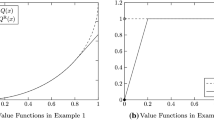Abstract
We consider totally unimodular (TU) stochastic programs, that is, two-stage stochastic programs whose extensive-form constraint matrix is TU. We generalize the notion of total unimodularity to apply to sets of matrices and provide properties of such sets. We provide several sufficient conditions on stochastic programs to be TU. When solving TU stochastic problems using the L-shaped method, it is not clear whether the integrality restrictions should be imposed on the master problem. Such restrictions will make each master problem more difficult to solve. On the other hand, solving the linear relaxation of the master typically means sending fractional (and unlikely optimal) solutions to the subproblems, perhaps leading to more iterations. Our computational results investigate this trade-off and provide insight into which strategy is preferable.
Similar content being viewed by others
References
Ahmed S., Tawarmalani M., Sahinidis N.V.: A finite branch-and-bound algorithm for two-stage stochastic integer programs. Math. Program. 100(2), 355–377 (2004)
Benders J.F.: Partitioning procedures for solving mixed-variables programming problems. Numer. Math. 4(1), 238–252 (1962)
Birge J.R., Louveaux F.V.: Introduction to Stochastic Programming. Springer, New York (1997)
Dhamdhere, K., Ravi, R., Singh, M.: On stochastic minimum spanning trees. In: Proceedings of the 11th International Conference on Integer Programming and Combinatorial Optimization (IPCO), pp. 321–334 (2005)
Ghouila-Houri A.: Caracterisation des matrices totalement unimodulaires. C. R. Acad. Sci. Paris 254, 1192–1194 (1962)
Hoffman A.J., Kruskal J.B.: Integral boundary points of convex polyhedra. In: Kuhn, H.W., Tucker, A.W. (eds) Linear Inequalities and Related Systems, pp. 223–246. Princeton University Press, Princeton (1956)
Klein Haneveld W.K., van der Vlerk M.H.: Stochastic integer programming: general models and algorithms. Ann. Oper. Res. 85, 39–57 (1999)
Kong N., Schaefer A.J.: A factor \({\frac{1}{2}}\) approximation algorithm for two-stage stochastic matching problems. Eur. J. Oper. Res. 172(3), 740–746 (2006)
Kong N., Schaefer A.J., Hunsaker B.: Two-stage integer programs with stochastic right-hand sides: a superadditive dual approach. Math. Program. 108(2), 275–296 (2006)
Louveaux F.V., van der Vlerk M.: Stochastic programming with simple integer recourse. Math. Program. 61(3), 301–325 (1993)
Nemhauser G.L., Wolsey L.A.: Integer and Combinatorial Optimization. Wiley, Hoboken (1988)
Ntaimo L.: Disjunctive decomposition for two-stage stochastic mixed-binary programs with random recourse. Oper. Res. 58(1), 229–243 (2010)
Padberg, M.W.: Characterizations of totally unimodular, balanced and perfect matrices. In: Roy, B. (ed.) Combinatorial Programming: Methods and Applications, pp. 275–284. Reidel (1975)
Schrijver A.: Theory of Linear and Integer Programming. Wiley, Hoboken (1986)
Schultz R.: Stochastic programming with integer variables. Math. Program. 97(1–2), 285–309 (2003)
Sen S., Higle J.L.: The C 3 theorem and a D 2 algorithm for large scale stochastic integer programming: Set convexification. Math. Program. 104(1), 1–20 (2005)
Sen S., Sherali H.D.: Decomposition with branch-and-cut approaches for two-stage stochastic mixed-integer programming. Math. Program. 106(2), 203–223 (2006)
Shmoys D.B., Swamy C.: An approximation scheme for stochastic linear programming and its application to stochastic integer programs. J. ACM 53(6), 978–1012 (2006)
Stougie, L.: Design and analysis of methods for stochastic integer programming. Ph.D. thesis, University of Amsterdam (1987)
Stougie, L., van der Vlerk, M.H.: Approximation in stochastic integer programming. Technical Report 03A14, University of Groningen, Research Institute SOM (2003)
van der Vlerk M.H.: Convex approximations for complete integer recourse models. Math. Program. 99(2), 297–310 (2004)
Van Slyke R., Wets R.J.B.: L-shaped linear programs with applications to optimal control and stochastic programming. SIAM J. Appl. Math. 17(4), 638–663 (1969)
Author information
Authors and Affiliations
Corresponding author
Additional information
Nan Kong was supported by Air Force Office of Scientific Research grant FA9550-08-1-0268.
Andrew J. Schaefer was supported in part by National Science Foundation awards DMI-0355433, CMMI-0620780, and CMMI-0826141. Shabbir Ahmed was supported in part by National Science Foundation awards DMI-0522485 and DMI-0133943.
Rights and permissions
About this article
Cite this article
Kong, N., Schaefer, A.J. & Ahmed, S. Totally unimodular stochastic programs. Math. Program. 138, 1–13 (2013). https://doi.org/10.1007/s10107-012-0529-8
Received:
Accepted:
Published:
Issue Date:
DOI: https://doi.org/10.1007/s10107-012-0529-8




